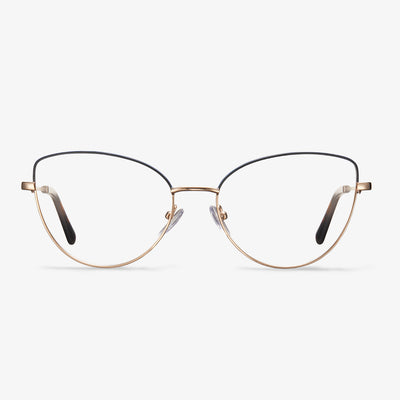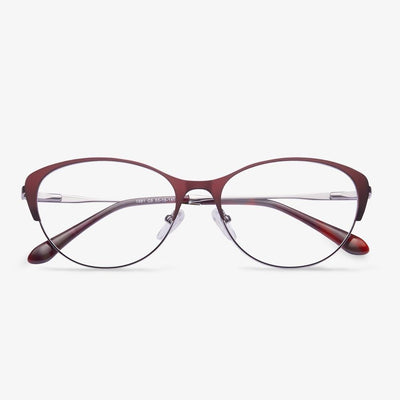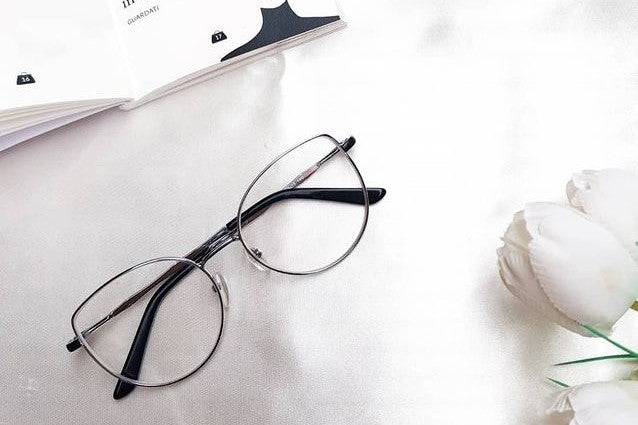What's the difference between optical frames and normal frame?
The optical frame is used in optical products, but decorative glasses and fashion frames are not in this category. Optical glasses require even treatment of lens pressure, so the inner wall should be even and smooth. Optical glasses require high levels of ergonomics, lens angle, and so on. The optical frame material is more consistent with the structure of the human body. It is more comfortable to wear without side effects.
Lunor - Glasses For Men
Many of Lunor's metal frames are made from high-quality titanium, gold, and stainless steel. In addition to the special process of making titanium, all-metal frames are made by hand in a factory in Germany, fully reflecting the craftsmanship and thought behind the production of the brand. The texture and professional demeanor of the glasses are strong. The brand is very good at combining classical and modern. What we can see is that the nose pad and the frames are made of pure titanium, so there's no allergic effect.
What Are Progressive Glasses?
Trifocal glasses and no-line progressive lenses are multi-focal glasses, meaning that their lenses offer multiple correction fields. Whether you have been wearing multi-focal glasses for a while, or you have just begun to look at options for correcting vision after 40 years old, you may have heard the terms trifocal or progressive glasses.
Progressive lenses offer a smooth transition from distance vision through intermediate vision to near vision, and they supply all the in-between corrections. Progressive lenses have three different viewing zones, as trifocal glasses do, and they have progressive powers of corrections, easing eye strain and providing the most natural vision correction.
Limitations of NXT lenses
NXT lenses made from Trivex can't be cut by means of traditional edge cutting ways, requiring certain edge grinders, which has caused some problems for retail stores. Therefore, now NXT lenses are more used in some glasses, like sunglasses, protective goggles, and so on.
Does it take time to get used to new prescription glasses?
People who wear new advanced glasses usually have an adjustment period. For novices, please gradually adapt to the glasses. In the first 2-3 weeks, increase the wearing time every day to adapt to the lens. For example, wear it for 1-2 hours on the first day, then add 2 hours a day until you feel comfortable. Before driving, please try it at home. Remember, you need to turn your head and move your eyes to find the 'sweet spot' for the activity you care about.
For experienced wearers, even under the same prescription, a new incremental pairing is required, and some adjustments are usually required. Progressive lens design, frame shape, and many other factors will also affect the adjustment time.
There are three processes for resin-changing lenses.
The incorporation method, known as bulk polymerization, is similar to the method of glass lens, that is, one or more photochromic dyes are directly incorporated into the polymer monomer of the substrate for bulk polymerization, and the lens formed after curing will change color. Discoloration dye is completely integrated into the resin lens substrate, so the lens made of color persistence is very good.
The uniformity of discoloration and the depth of color after discoloration are highly related to the thickness of the lens. Because the thickness of the lenses at all levels is different, there will be a color difference between the depth of discoloration and the uniformity, and the uneven phenomenon of high brightness is more obvious.
The film type is known as the coating method. It is the chromatic resin lens by coating or dipping in a layer of chromatic dye on the base of the resin lens. Because the coating covers the surface of the lens, the color uniformity is good. The coating, which is only about 0.05mm thick, does not provide enough molecules to make the lens dark enough, so the color is relatively less dark, and the discoloration lasts slightly longer.
Infiltration, known as the penetration method, is to use the principle of penetration, through the thermal diffusion method to make the color dye permeate the surface of the resin lens sheet material, with diffusion depth up to 0.15~0.20mm. The lens has a constant color change characteristic. There will be no inconsistency between the center and the surrounding color as the luminosity gets darker. The color-changing resin lens made by infiltration type has the benefits of uniform color-changing, small color difference, fast and thorough color-fading, which is the mainstream of color-changing technology at present.
3 Common Problems with Progressive Lenses
Though progressive lenses are popular to correct some eye conditions, there are also some drawbacks. So, in the following section, we will show you some common problems with progressive lenses.
Dizziness: the three different focal lengths of progressive lenses can make people susceptible to dizziness, as well as vertigo. From long to medium to short distance, the lenses offer a gradient of increasing strength. So, it would have trouble in adapting the glasses for the people who are wearing them for the first time. A common mistake is to look out of the wrong focal length, causing their vision to be blurry and lead to an overall feeling of dizziness.
Peripheral distortion: another common problem of progressive lenses is the way in which they blur peripheral vision. Most glasses cause an initial distortion to vision. However, the three different segments found in these lenses can make that distortion feel more prominent than other pairs of eyeglasses. And most people may need two weeks to adjust to progressive lenses.
Depth perception: Since progressive lenses provide three different prescriptions to see objects clearly for different distances, it is important that you need to move your head instead of your eyes when focusing on objects at different distances. Prior to adjusting to this little nuance, progressive lenses can cause depth perception to feel off.
From the above information, you have known some common problems with progressive lenses. So, you may ask how to adjust the progressive lenses. The most popular way is that you need to wear them frequently.











































